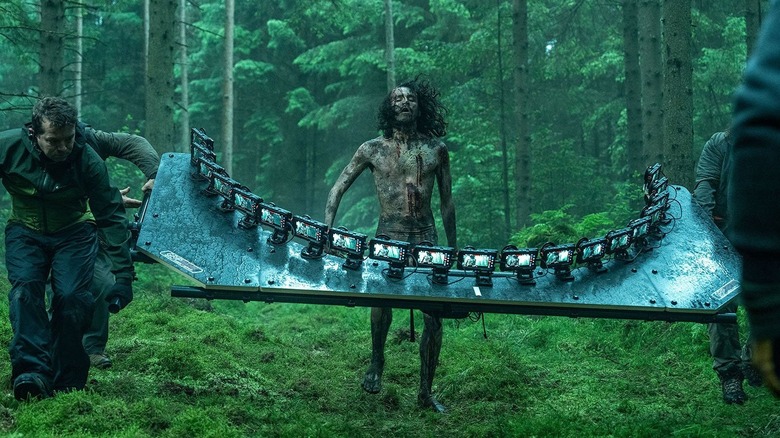The Custom iPhone Rig They Made To Film 28 Years Later Used Up To 20 Cameras At Once
If you read any interview where an established film director is asked about advice for aspiring filmmakers, they'll probably mention how equipment that was once out of reach is more accessible than ever. That's because most people now have high-quality videocameras in their pockets in the form of devices like the iPhone. Of course, you can't expect to just pull out your iPhone from your pocket and start shooting. You still need quality software to control elements like exposure, frame rate, and more. Craft is still essential to making a film shot on an iPhone look great.
Many high-profile films have been shot on iPhones, including those by Oscar-winning directors. Sean Baker used an iPhone 5S for his 2015 feature "Tangerine." Steven Soderbergh has used iPhones a couple of times, with the iPhone 7 Plus for 2018's "Unsane" and the iPhone 8 for 2019's "High Flying Bird." The most recent iPhone user is Danny Boyle, who chose to utilize the iPhone 15 Pro Max for some of the shots in "28 Years Later." In all these cases, filmmakers had to construct a rig for the iPhone, and the one for "28 Years Later" is easily the most elaborate, as it was constructed to hold up to 20 different iPhones. With this rig, Boyle and cinematographer Anthony Dod Mantle could capture certain sequences from 20 different angles in order to have many different shots to choose from across a 180-degree plane. All of these options give Boyle and editor Jon Harris so many possibilities in the editing suite.
Why did '28 Years Later' shoot with iPhones in the first place?
The first film in this series, "28 Days Later," was released in the United Kingdom in 2002 before making its way to the United States in June 2003. This was before the smartphone was a thing, and the idea of recording a short video on your phone was silly, let alone a whole movie. However, when Danny Boyle was preparing to shoot that film, the decision was made to shoot most of it with the Canon XL1 camera. While 35mm photography was the standard at the time, "28 Days Later" instead used a consumer-grade DV tape camera with a resolution of only 480p. By using the XL1, Boyle and the crew could shoot scenes incredibly efficiently. Plus, it gave the film a grimy, rough texture that aided in depicting the desolation of England after a zombie outbreak.
The iPhone 15 Pro Max is simply the logical extension of this methodology. These are now the consumer-grade cameras that anyone can pick up and shoot with, but the difference now is that this iPhone can capture video with 4K resolution with a high dynamic range. The gap in fidelity between what the average person has and what professionals use has shrunk, which is why you may not even realize that "28 Years Later" uses an iPhone for much of its photography. Because of their small size, they pair very well with the usability of the Canon XL1, but you wouldn't be able to build that nimble 20-camera rig with 20 celluloid film cameras. And that's why it had to be iPhones.

